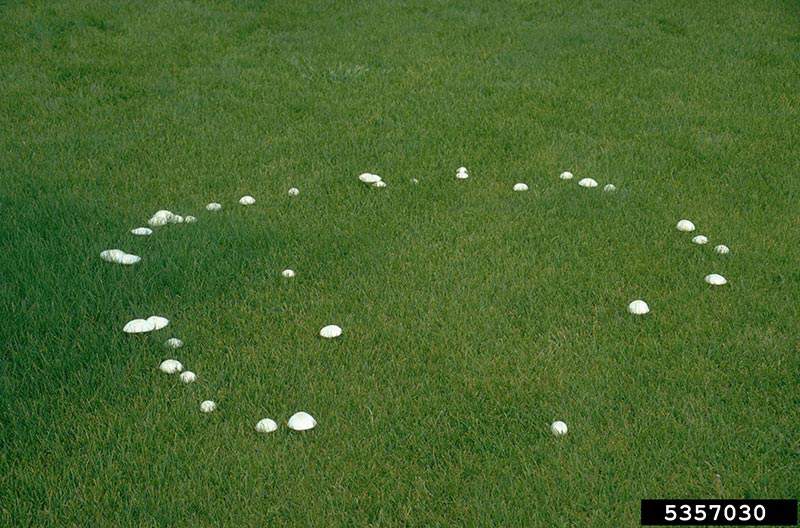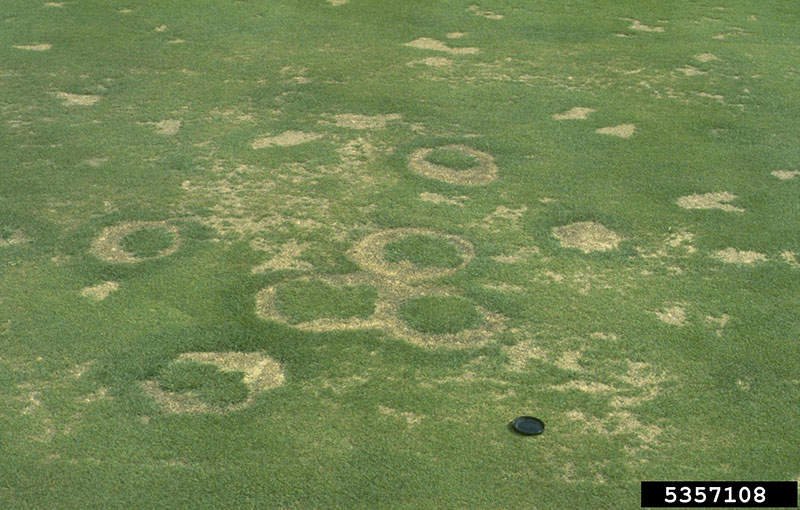How to Identify and Control Fairy Rings
When lawn disease strikes, your dreams of a thick, beautiful lawn may seem to slip out of reach. But the solution to your problems can be as simple as disease I.D. and changes in your lawn care routine. Most common lawn diseases start with fungal pathogens that can't flourish unless conditions favor their growth. With proper lawn disease identification and disease-fighting culture, you can control disease and enjoy a healthy lawn.
Midsummer is high season for fairy rings, but this fungal lawn disease stays active from spring into late fall. No common lawn grass species — cool-season or warm-season grasses — are immune to this disease, which arises from at least 40 separate fungal species.1,2

Lawn with a ring of mushrooms, typical of Type 3 infection with fairy ring fungi.
- Symptoms and signs: Large, irregular rings throughout your lawn reveal fairy rings at work. Rings may be dark green from the fungi's release of nitrogen, or rings may be tan, with green grass within. Telltale puffballs or mushrooms appear along the ring. Fairy ring areas may repel rainfall and irrigation.
- Contributing factors: The fungi behind fairy rings depend on dead or decaying organic matter for their survival. Soil with overly high organic matter or turf with excessive thatch contribute to the disease.
- Cultural control: When starting a new lawn from seed, avoid high-organic soil mixes and remove any wood pieces or excess organic matter before you seed. Dethatch your lawn, if needed, and keep it hydrated well. If necessary, core aerate affected lawn areas so water can penetrate the root zone. When cultural controls fail to manage fungal lawn diseases, a lawn fungicide can help. As with garden fungicides, early treatment is key to preventing fungal pathogens from germinating and spreading. Many effective fungicides are available only to lawn professionals. Your local county extension agent is an excellent source for information on lawn fungicides and their use for lawn diseases.

Lawn showing symptoms of infection with fairy ring fungi. Lens cap provided for scale.
For any type of lawn disease, choosing disease-resistant grass varieties plays an important role in disease prevention and control. Superior grass varieties such as purebred Pennington Smart Seed grasses are backed by decades of industry-leading research and breeding to provide you with the finest in sustainability-enhancing lawn grasses with outstanding disease resistance.
By being proactive and providing your lawn with the care it needs, you can restore balance and enjoy a thick, healthy lawn again. Pennington is here to help with timely, expert lawn advice and premium seed and lawn care products, so you can know the satisfaction of a disease-free lawn you're proud to call your own.
Pennington with design and Smart Seed are trademarks of Pennington Seed, Inc.
Sources:
- NextGen Turf Research, "Disease Overview: Turfgrass Disease," April 2016.
- Bruneau and Lucas, "Diseases of Warm-Season Grasses," North Carolina State Extension, August 1995.
Photo credit: Lester E. Dickens, Bugwood.org (CC BY 3.0 US)
Photo credit: William M. Brown Jr., Bugwood.org (CC BY 3.0 US)




